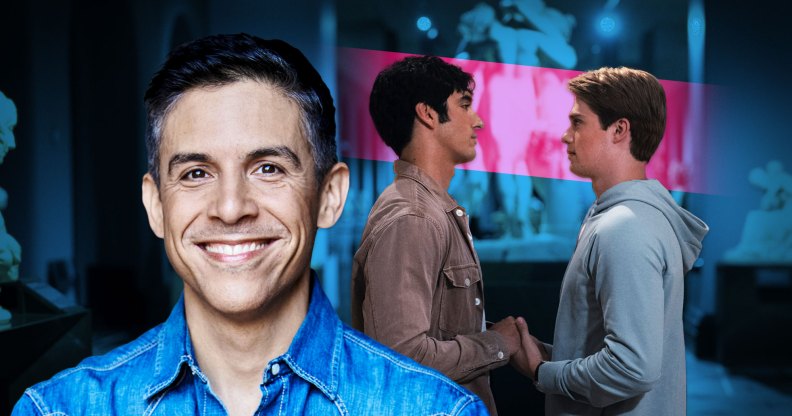Red, White & Royal Blue director explains why the film’s ‘audacious’ ending is so important to him

Director Matthew López made his Red, White & Royal Blue decisions for a reason. (Supplied)
Fans of Casey McQuiston’s bestseller Red, White & Royal Blue will be pleased to know that director Matthew López kept the book’s “audacious” happy ending for his much-hyped film adaptation.
López has explained that a queer happy-ever-after was often missing in LGBTQ+ films in the 90s and noughties, with the few LGBTQ+ stories available tending to be “about death and dying”.
McQuiston’s 2019 novel Red, White & Royal Blue, revolves around the British Prince Henry, played by Cinderella’s Nicholas Galitzine, and Alex Claremont-Diaz, portrayed by The Kissing Booth 2‘s Taylor Zakhar Perez.
Oh, and Alex is the son of the first female present of the United States, played by Uma Thurman.
The story is the classic tale of enemies-to-lovers, as the pair start off as rivals. A fight breaks out at a party, leaving them on the floor covered in wedding cake. As they’re forced to begin a faux friendship to prevent an international incident, they fall for each other.
There were a lot of changes made to adapt the book to the big screen, including the erasure of Alex’s sister, June.
One thing that hasn’t changed, however, is the happy ending.
Subverting the ‘bury your gays’ trope
The lovers overcome all the obstacles along the way, with the film ending as they head to Alex’s childhood home to celebrate their happy ever after.
Talking about why he kept the book’s joyful ending, López told Digital Spy: “When I was growing up as a baby gay, what few stories there were about being queer were always about death and dying.
“So I think one of the reasons I was drawn to this story in the first place was that it had a happy ending. There weren’t happy endings in queer movies when I was growing up.”
This trope of LGBTQ+ characters dying in film and TV – especially female characters – is so common in Hollywood, it’s known as “bury your gays”.
It became so prevalent that one nonprofit organisation, LGBT Fans Deserve Better, was created in response.
“For someone my age, there is something audacious about a happy ending in a queer story.”
Matthew López
López continued: “I don’t think it really occurred to me that’s probably one of the reasons until after I finished the film. I mean, it sounds so simple, and also sad to be able to report that just is not how queer movies ended in the 90s and the early aughts.
“I don’t think that the younger generation for whom this film is made would see it as revolutionary, but for someone my age, there is something audacious about a happy ending in a queer story.
“But I also love that it isn’t audacious anymore. We absolutely want a happy ending for those two characters. We want them to be happy because we want to be happy ourselves.”
López has previously spoken to PinkNews about the importance of showing great gay sex on screen – the two lead stars worked with an intimacy co-ordinator to ensure the scenes were realistic.
“We need to actually believe that Alex and Henry have really great, connected sex,” López said. “That, as a queer man, was really important to me to convey.”
The director also hinted at a possible sequel to Digital Spy – provided McQuiston has more ideas for the story. “I wouldn’t do it without first getting Casey’s blessing and mining Casey’s brain,” he added.
Red, White & Royal Blue is now available to watch on Prime Video.
How did this story make you feel?

